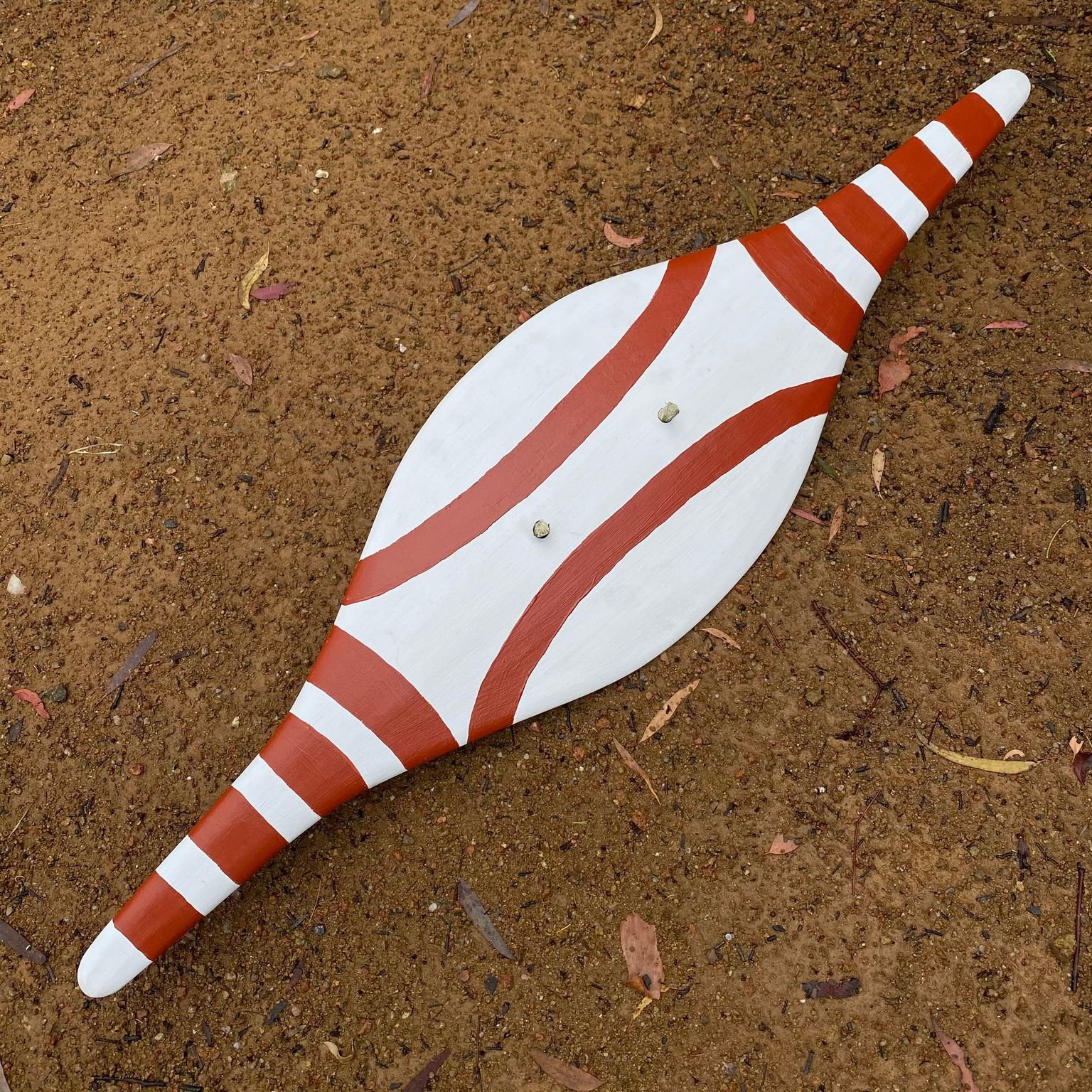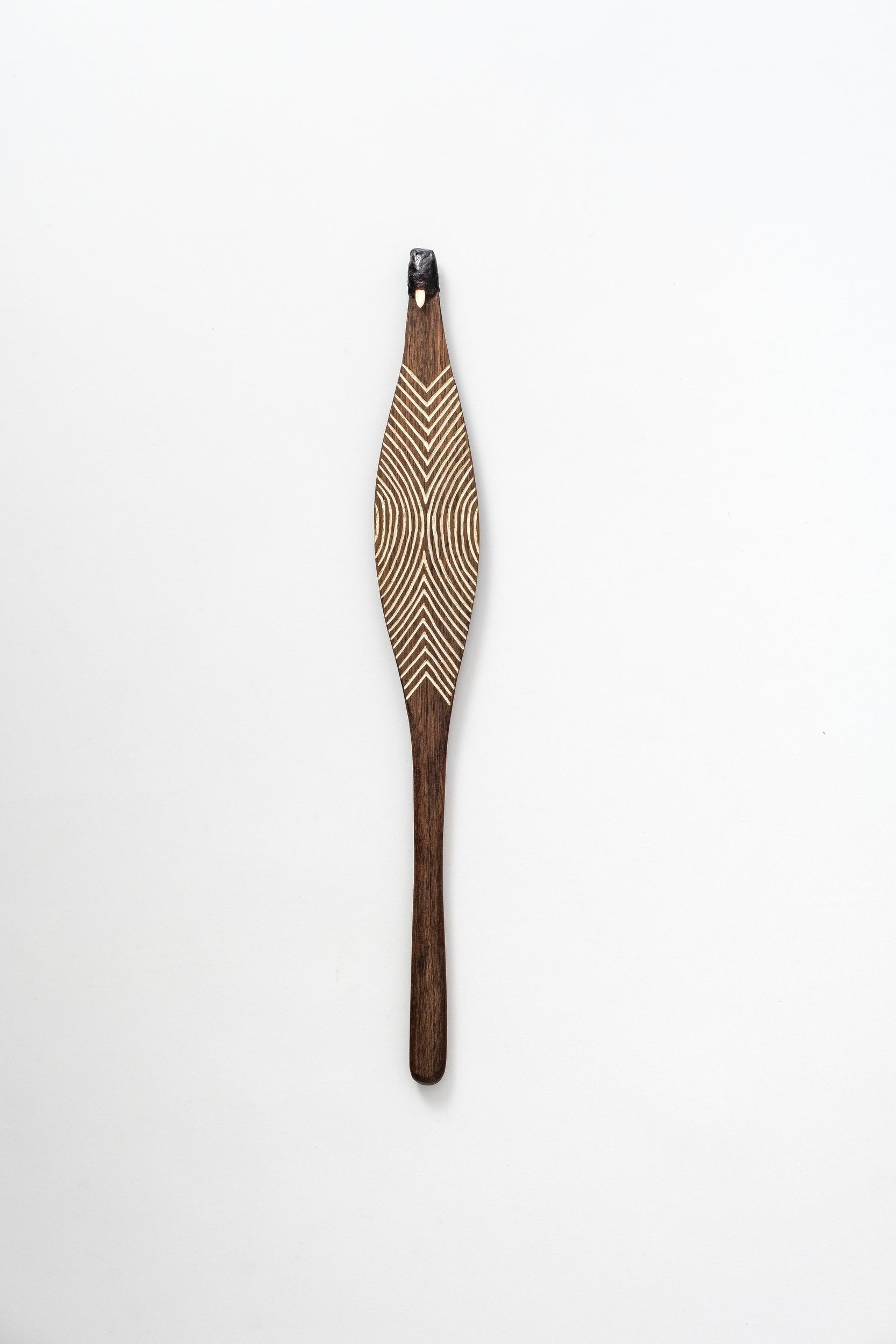Q&A with ... James Tylor
Detail from Mudlirna installation in Gallery Two. Photo: Connor Patterson.
Carly Tarkari Dodd, Kaurna Curator, talks to Kaurna artist James Tylor about taking control of the misrepresented cultural narrative of Kaurna culture and language.
James Tylor, a multidisciplinary artist with Nunga (Kaurna Miyurna), Māori (Te Arawa) and European (English, Scottish, Irish, Dutch and Norwegian) ancestry, showcases a new body of carved Kaurna objects in his solo exhibition Mudlirna at JamFactory Tarntanya/Adelaide for the Tarnanthi Festival of Aboriginal and Torres Strait Islander Art.
Taking an important stance on how non-Indigenous individuals have historically misrepresented Kaurna culture in museums and galleries, Tylor challenges racial stereotypes and offers the Kaurna people the rightful recognition they deserve. Through this exploration of Kaurna art and design from a Kaurna perspective, Mudlirna signifies a renaissance of Kaurna cultural arts in a contemporary art context.
In the past you have studied photography at the University of South Australia and Tasmania; over the years, how has the relationship between your photography and your cultural objects developed within your practice?
Being a Kaurna photographer allows me to document Kaurna culture in several important ways. I photograph and record Kaurna cultural artefacts held in museum collections in Australia and overseas to make them available to the Kaurna community and to assist contemporary cultural revival. As a contemporary Kaurna maker, I can document all aspects of making Kaurna cultural design objects from start to finish. I can document the places where I collect material on Kaurna country, as well as the making process and how I display cultural objects when they are finished. I can present them in a gallery exhibition or on digital platforms, such as Instagram, to help other people learn about Kaurna culture.
What do you think seeing Murlirna will mean to the Kaurna community and what do you hope that they will experience seeing your artworks?
I think it’s important to show other Kaurna people what I’ve made over the years to prove to them that you can pursue culture throughout your life, make cultural objects and continue culture. It shows that the culture isn’t broken, that it is a long chain of thousands of years of cultural making. You can see that it’s moving into the next generation on from me to my son and it shows that culture has always been there and will be there in the future. For non-Indigenous people it’s a good basic educational tool to learn a bit more about Kaurna culture and they can learn a little bit of language in the process.
James Tylor, Murlapaka Broadshield. Photographer: the artist
Midla Spearthrower (Chevron and bands pattern), 2023, black wattle, kangaroo tooth, natural fibre, grass tree resin & animal fat, 560x80x20mm, Photographer: Connor Patterson
Do you think the way that Kaurna culture is represented in Adelaide is tokenistic? I think there needs to be more natural engagement process, not just that cultural transaction.
I want to hope it’s not tokenistic, but I believe it is. There are non-Indigenous people that are willing to have healthy engagements with culture, language, land, and the Kaurna community, but I think the vast majority are socially obligated to engage with our community and sadly as a result it has become meaningless tokenism through basic acknowledgements, tick box reconciliation action plans etc. It is important to highlight Kaurna is the primary cultural and language of the Adelaide region, even though it is not the main spoken language today, it has been spoken here for thousands of years before the British invaded and stole our land, and attempted to destroy our culture, language, family, and land. It is important to highlight that this continues today. Kaurna and English needs to be the primary languages spoken, so non-Indigenous people need to have a basic understanding of our language and culture. And at this point “Niina Marni” (hello) and “Nakutha” (goodbye) are not enough of an engagement with language or culture. The people of Adelaide really need to try harder. You go on holiday to any European country - for example you go to Italy and say ‘ciao’ - and that’s about the level of engagement non-Indigenous people in Adelaide have with the Kaurna language. Non-indigenous people behave like they own our land, but they are simply badly behaving tourists here, to be honest no different to most Australians overseas. That really needs to change!
I think in the past five or ten years there has been a big change in the Kaurna community of people being more active and I think in the visual arts and craft realm there hasn’t been that kind of activity until quite recently. In the next ten years, what would you like to see in the Kaurna art, craft, and design area?
In the last five to ten years there has been an explosion of Kaurna people working in the cultural sector - mostly providing welcome to country and cultural education. Ten years ago, there was only two or three of us in the visual arts sector in South Australia and now it has increased significantly. I want Kaurna culture to be a normal and everyday part of arts in Adelaide; for example, seeing language as being interchangeable with English. Any artwork, event or exhibition that engages with our local Kaurna environment, history of culture in Adelaide should go through the Traditional Owners - the Kaurna community.
I want to see Kaurna people represented in every cultural organisation, not just one person but multiple people, as well as Nunga South Australian Aboriginal people being able see that there are career opportunities in the cultural sector in South Australia. It would be great if there were more pathways from schools and universities created for young Nunga people to pursue a career in the South Australian arts and cultural sectors. It would allow Aboriginal culture to be a normal part of South Australian society again, become stronger in the future and have positive outcomes for our communities.
Taiyaruki Parry Shield 2023 black wattle, ochre, animal fat, 530 x 90 x 90. Photographer: the artist
James invites all Australians to engage with Kaurna language, culture, history, and environments in a meaningful and respectful way.
Mudlirna is showing at JamFactory Tarntanya/Adelaide from until December.
Discover more about the objects featured in the exhibition, what they are made from, their use and pronunciation!




